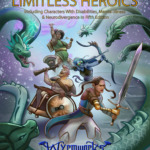Eye Color Difference

One or both of your eyes are colored outside the usual range of hues typical for your ancestry. Choose or roll on the following table.
| d20 | Eye Region |
|---|---|
| 1–3 | Pupil |
| 4−10 | Iris |
| 11−17 | Sclera (Whites) |
| 18–20 | Entire eye |
The player and GM can choose the color or roll it randomly at https://www.random.org/colors/hex, ignoring results that would be typical unless only one eye is affected. While this coloration is relatively easy to cover, those who see it who aren’t familiar with you in some cultures may associate it with otherworldliness and evil, so this gives you a −1 penalty on Charisma (Persuasion) checks but +1 on Charisma (Intimidation) checks.
Real-world Examples
Jaundice, Primary Acquired Melanosis, Subconjunctival Hemorrhage, Osteogenesis Imperfecta, Marfan’s Syndrome, Anemia
Assistive Options
Eye Dye: This translucent pigment can change lighter colors into darker but not the opposite. Such dye lasts 4d6 + 30 minutes and tints the entire eye with the color. The dye irritates the eye, so when it wears off, the eye will be bloodshot for 2d4 hours after. Where available, a vial of 20 uses typically sells for 1 gp.
A specialized artisan can craft a pair of sunglasses costing 200 gp to conceal your eyes.